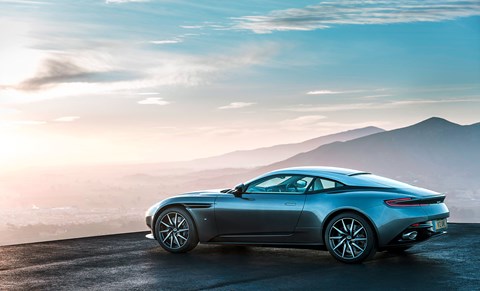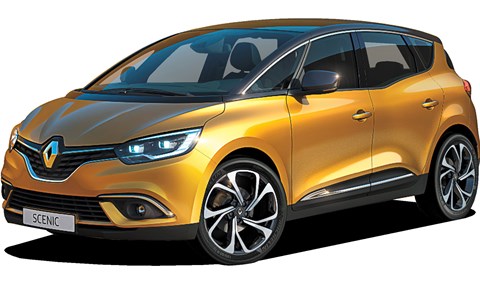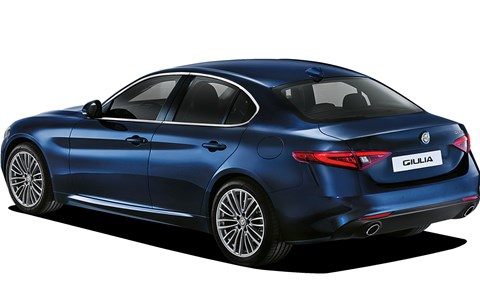► The stories that shook the 2016 Geneva show
► DS brings a supercar to the competition table
► Renault Scenic rolls out on 20in wheels as standard
1) DS’s surprise supercar
Everywhere you looked in Geneva lurked the biggest names peddling the fastest cars: Bugatti! Lamborghini! McLaren! Pagani! Pininfarina unveiled a fuel-cell-powered supercar capable of exceeding 300kmh, Koënigsegg showed the 1500hp hybrid Regera. But the supercar from the most unlikely source was the E-Tense concept from Peugeot’s upstart premium brand DS.
The company hasn’t let its lack of eight- or 12-cylinder supercar engines hold it back: the E-Tense is pure electric. It’s built on a carbonfibre monocoque, housing lithium-ion batteries low to drop the centre of gravity, suspended via double wishbones. The electric powertrain produces 402bhp and 380lb ft of instant shove, said to propel the DS from stop to 62mph in 4.5sec. The zero emissions range is up around 200 miles.
Think this concept is all claim and no game? Arnaud Ribeau, DS global sales and marketing director, told CAR: ‘You can drive it in a few weeks, in front of the public. The technology inside it is real, it’s linked to the technology in our Formula E racing car. We’re using it as a laboratory to prepare our future.’
Racing in Formula E, and having signed an agreement with Canadian province Quebec to jointly fund components for high performance electric cars, DS is making it clear that it will launch Peugeot-Citroën into the EV race around 2020.

2) Britain means business
It’s jingoistic to claim one’s indigenous car makers ‘stole’ the show, so we’ll settle for Aston Martin and McLaren outlining uplifting visions for the next six years. Unveiling the new DB11 – ‘the catalyst for our transformation’ (translation: do-or-die revenue generator) – Aston boss Andy Palmer promised a new car every nine months, as the company replaces its entire range by 2020 and adds three new models. Aston has also confirmed a new factory in St Athan, Wales, to build its new crossover, creating 3000 jobs directly and in the supply chain. The modernisation programme also includes low-emission vehicles, starting with an electric Rapide in 2018.
McLaren Automotive will similarly transform its powertrains, introducing a second, downsized engine family with hybrid assistance. CEO Mike Flewitt predicted more than 50% of McLarens will be petrol/electric by 2022, and confirmed investigative work to see if the next P1 ultimate car could run on electric power alone. In total, McLaren will invest £1bn over the next six years, introducing 15 new cars starting with next year’s
570S roadster.

3) The MPV’s last stand
Bugatti-sized 20-inch wheels as standard, rakish roofline, two-thirds/one-third body/glasshouse ratio, surely that’s a sports coupe? Nope, that’s the new Scenic, Renault’s daring attempt to revive the MPV – a market segment that five years ago outsold SUVs, but is now dwarfed by them 2:1, according to JATO figures. ‘For Renault to give up the Scenic would be for us to give up our heart and soul,’ says design director Laurens van den Acker. ‘An MPV’s lack of attractiveness is linked to the fact it’s a box on wheels. Our MPV has four USPs – those four 20in wheels!’ The undulating window line, snub nose and optional two-tone roof add to the effect, but the rims (which are the only wheel choice) transform the proportions. The designer admits he had to overcome internal protests on cost, weight and marketing grounds – bang goes one stream of option revenue. UK sales begin in November, and van den Acker admits he hasn’t got a clue how it will sell. ‘I’m really curious about who will buy it. But we tried something, it’s real Renault.’

4) The real MPG battle
Volkswagen remains under the dieselgate cosh: its press conference was gatecrashed by a British comedian pretending to fit a ‘cheat box’ to the facelifted Up, then PSA Peugeot-Citroën announced real-world consumption figures for three cars and an intention to extend this transparency across the range. ‘It’s not dieselgate, it’s VW-gate,’ PSA chief Carlos Tavares chided CAR. ‘VW-gate created a lot of concern and we are Europe’s leader in [low] CO2 emissions; we have the most to lose if there’s a break in consumer trust.’
So PSA has collaborated with a green lobby group and a French certification agency to pre-emptively implement the RDE real-world consumption test, due in 2017. PSA’s tests are carried out on public roads, with cars subject to more representative loads, air-con, gradients, acceleration and weather conditions than the discredited NEDC lab test that magics up the current official figures. The 120PS 1.6-litre diesel in the Peugeot 308, Citroën C4 Grand Picasso and DS3 yielded between 50 and 57mpg in the tests, around 30% off their NEDC figures. PSA will publish the results, and soon extend the data to include CO2 and nitrogen oxides.
While PSA is clearly trying to further its rival’s discomfort for commercial reasons, its proactivity intensifies momentum behind the introduction of stricter tailpipe tests, to better inform consumers. Will VW follow suit?
‘I can understand why PSA has done this,’ said VW sales chief Jürgen Stackmann. ‘We are all aiming for the same thing, something which is closer to reality. In our case it would just lead to further confusion. We will wait until the norms change in Europe, and these norms are fully transparent, comparable and fully measurable.’

5) The Alfas are coming! Slowly
Entry-level Giulias, we’ve been expecting you – for the best part of six months. Production should be underway as you read this, with right-hand-drive build scheduled for September. Aside from the 510bhp V6 Quadrifoglio, three four-cylinder variants will be offered: a 2.2-litre turbodiesel with 150bhp or 180bhp, and a 200bhp 2.0-litre turbo petrol.
With strategic use of aluminium and a carbonfibre propshaft, the rear-wheel-drive chassis is pretty lean: the 180bhp diesel version weighs 1449kg (with fluids). Expect 0-62mph in 6.8sec for the eight-speed auto, coupled with 67.2mpg and 109g/km. There’ll be a tax-friendly 99g/km ‘eco’ model for business users, and 480 litres of luggage space – identical to its German rivals. Could the Giulia provide the perfect blend of rational and emotional? We’ll find out when test drives begin in May.

6) VW opens fire on Juke
Volkswagen Group went SUV crazy at Geneva: Seat and Skoda showed their Tiguan-sized crossovers, while VW and Audi targeted the segment below. The T-Cross concept previews a Polo SUV, while the Q2 (above)marks the first premium German push into the B-SUV segment – ominous news for the Nissan Juke, Vauxhall Mokka et al.
An Audi spokesman said the Q2, likely to cost around £20,000, was a ‘Trojan horse’ aimed at attracting a younger buyer into the brand, then into another Q model. The crossover has plenty of premium Technik, such as the virtual cockpit which can deploy a beautifully rendered navigation map or other info in the binnacle, WiFi hotspot capability, and traffic-jam assist which enables the Q2 to self-drive at up to 40mph.
The engine range spans 1.0- triple, 1.4- and 2.0-litre petrols, and 114bhp 1.6- and 148bhp 2.0-litre TDIs. And this being an SUV, of sorts, quattro all-wheel drive will be available on the 2.0-litre engines. Will the Q2 cannibalise mainstream sales, or grow the market? Analysts IHS expect SUVs to account for 27% of all European sales by 2020, up from 20% in 2014. No wonder mainstream VW had such a single-minded approach to Geneva.
Read more from the April 2016 issue of CAR magazine